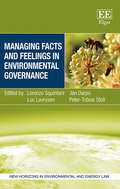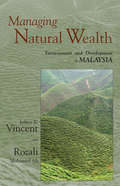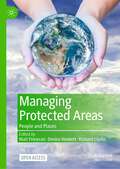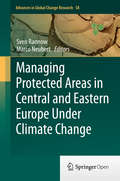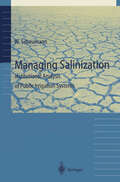- Table View
- List View
Managing Environmental Risks through Insurance: Legal and Economic Aspects (AIDA Europe Research Series on Insurance Law and Regulation #9)
by Katarzyna Malinowska Dorota MaśniakThis book identifies the role of insurance in a comprehensive system for managing environmental risks at the local, regional and global level. National and international legal instruments regulating environmental protection, especially aspects like pollution, are not precisely reflected in insurance concepts intended to cover environmental risks. As such, there is a need to identify environmental risks and to propose a taxonomy of environmental risks for various types of insurance coverage. The authors refer to the issues of liability in environmental protection, the scope of insurance coverage and comment on specific issues the importance of which has been noticed by the legislator or insurance practice. The book examines these issues horizontally and vertically from various standpoints, focusing on insurance as a means of managing environmental risks. In this regard, it mainly concentrates on (1) identifying and analyzing environmental risks and methods for managing them via private and public instruments, and (2) insuring these risks. The book is intended for all those interested in the field of insurance and environmental risk regimes, including lawyers, academics and legal professionals.
Managing Europe's Water Resources: Twenty-first Century Challenges (PDF)
by Chad StaddonIllustrated with case studies which explain key concepts and provide practical examples, this book provides a detailed and comprehensive introduction to water management issues from a European perspective. The book begins with a brief history of water management, followed by a consideration of the major frameworks used for managing water in its qualitative and quantitative aspects. Several chapters treat key water management issues, including; dams, privatization, hydropolitics, climate change and finally provides a synoptic treatment of major water management issues across Europe's geographical regions.
Managing Europe's Water Resources: Twenty-first Century Challenges
by Chad StaddonIllustrated with case studies which explain key concepts and provide practical examples, this book provides a detailed and comprehensive introduction to water management issues from a European perspective. The book begins with a brief history of water management, followed by a consideration of the major frameworks used for managing water in its qualitative and quantitative aspects. Several chapters treat key water management issues, including; dams, privatization, hydropolitics, climate change and finally provides a synoptic treatment of major water management issues across Europe's geographical regions.
Managing Facts and Feelings in Environmental Governance (New Horizons in Environmental and Energy Law series)
by Jan Darpö Lorenzo Squintani Luc Lavrysen Peter-Tobias StollFacts and feelings constitute a complex tension in modern science. Not only can public opinion deviate from scientific knowledge, but that knowledge itself can be lacunose or contradicting. Managing Facts and Feelings in Environmental Governance examines this internal friction, between the need to engage the public in the importance of environmental governance and the demand of professional expertise to address the issues that arise. This timely and insightful book acknowledges the growing role of behavioural science in the determination of environmental policy, regulation and decision-making, providing astute guidance to decision-makers regarding how to balance the needs of public participation procedures and professional expertise. Its multidisciplinary approach provides new insights in the field of public participation, enabling further analysis of environmental psychology, equality law and fundamental rights, and offers concrete guidance on how to approach natural science in court. Engaging with the role that the precautionary principle can play in balancing tensions between public and academic spheres, this book includes a state-of-the-art account of the precautionary approach under EU and international law. Combining law in action with academic approaches, this book is a must-read for scholars of environmental law, governance and regulation. It also offers valuable guidance for decision-makers and NGOs active in environmental protection, as well as environmental lawyers at national, European and international levels.
Managing Forest Carbon in a Changing Climate
by Mark S. Ashton, Mary L. Tyrrell, Deborah Spalding and Bradford GentryThe aim of this book is to provide an accessible overview for advanced students, resource professionals such as land managers, and policy makers to acquaint themselves with the established science, management practices and policies that facilitate sequestration and allow for the storage of carbon in forests. The book has value to the reader to better understand: a) carbon science and management of forests and wood products; b) the underlying social mechanisms of deforestation; and c) the policy options in order to formulate a cohesive strategy for implementing forest carbon projects and ultimately reducing emissions from forest land use.
Managing Hazardous Air Pollutants: State of the Art
by Winston Chow Katherine ConnorManaging Hazardous Air Pollutants presents a detailed examination of the state-of-the-art in the management of air pollutants ("air toxics"). This important new volume focuses on the latest research, regulatory perspectives, modeling, environmental and human risk assessments, new control strategies, monitoring programs, risk communication, and risk management. Key chapters in the book are devoted to these timely subjects:
Managing Hazardous Air Pollutants: State of the Art
by Winston Chow Katherine ConnorManaging Hazardous Air Pollutants presents a detailed examination of the state-of-the-art in the management of air pollutants ("air toxics"). This important new volume focuses on the latest research, regulatory perspectives, modeling, environmental and human risk assessments, new control strategies, monitoring programs, risk communication, and risk management. Key chapters in the book are devoted to these timely subjects:
Managing Landscapes for Change (Landscape Series #27)
by Robert M. SchellerThis book discusses how future landscapes will be shaped by pervasive change and where, when, and how society should manage landscapes for change. Readers will learn about the major anthropogenic drivers of landscape change, including climate change and human induced disturbance regimes, and the unique consequences that multiple and simultaneously occurring change agents can have on landscapes. The author uses landscape trajectories as a guide to selecting the appropriate course of action, and considers how landscape position, inertia, and direction will determine landscape futures. The author introduces the concept of landscapes as socio-technical-ecological systems (STES), which combines ecological and technological influences on future landscape change and the need for society to acknowledge both when considering landscape management. Thinking beyond solutions, the author identifies barriers to managing landscapes for change including the cost, cultural identity of local populations, and the fear of taking action under uncertain conditions. Nevertheless, processes, tools, and technologies exist for overcoming social and ecological barriers to managing landscapes for change, and continued investment in social and scientific infrastructure holds out hope for maintaining our landscape values even as we enter an era of unprecedented change and disruption.
Managing Natural Resources: Organizational Strategy, Behaviour and Dynamics
by Gerard George Simon J. D. SchillebeeckxManaging the natural environment is fundamental to many businesses, yet management scholars have understudied how natural resources are acquired and deployed, how they constrain and challenge strategy and innovation, and how they differ from more conventionally studied resources in management. This book captures leading and thought-provoking conceptual and empirical contributions on how organizations (ought to) interact with such natural resources. Utilizing a distinctly managerial approach, the chapter authors explore topics such as interorganizational relationships, strategic responses, and risk and resilience at the interface of the natural environment. By applying and extending management theories such as resource dependence, transaction costs, the resource-based view, dynamic capabilities and imprinting in a natural resource context, the authors open up multiple avenues for future research. At the same time, they seek to actively build a global community of management scholars interested in natural resources. Multidisciplinary in approach and clear in execution, this book will be of interest to students and researchers studying natural resource management and policy, policymakers from regional, national, and transnational bodies, as well as leaders of environment focused NGOs.
Managing Natural Wealth: Environment and Development in Malaysia
by Jeffrey R. Vincent Rozali Professor Mohamed AliThe remarkably rich natural environment of Malaysia attracts the interest of both industry and the environmental community. Managing Natural Wealth analyzes major natural resource and environmental policy issues in the country during the 1970s and 1980s-a period of profound socioeconomic change, rapid depletion of natural resources, and the emergence of serious problems with pollution. Managing Natural Wealth is an important up-date to Environment and Development in a Resource-Rich Economy: Malaysia under the New Economic Policy. First published in hardcover in 1997, this pathbreaking book emphasized economics as a source for analyzing the issues involved in environmental and natural resource management in developing countries. The access that Jeffrey Vincent and Rozali Mohamed Ali and the contributing authors had to unpublished data and key decisionmakers made their account an essential reference for policymakers and researchers in Malaysia and throughout the globe. Managing Natural Wealth includes a review of key developments since the 1990s by S. Robert Aiken and Colin H. Leigh, two geographers with a long-standing interest in environmental change in Malaysia and an understanding of the institutional context of its environmental policy that is unmatched in the scholarly community.
Managing Natural Wealth: Environment and Development in Malaysia
by Jeffrey R. Vincent Rozali Professor Mohamed AliThe remarkably rich natural environment of Malaysia attracts the interest of both industry and the environmental community. Managing Natural Wealth analyzes major natural resource and environmental policy issues in the country during the 1970s and 1980s-a period of profound socioeconomic change, rapid depletion of natural resources, and the emergence of serious problems with pollution. Managing Natural Wealth is an important up-date to Environment and Development in a Resource-Rich Economy: Malaysia under the New Economic Policy. First published in hardcover in 1997, this pathbreaking book emphasized economics as a source for analyzing the issues involved in environmental and natural resource management in developing countries. The access that Jeffrey Vincent and Rozali Mohamed Ali and the contributing authors had to unpublished data and key decisionmakers made their account an essential reference for policymakers and researchers in Malaysia and throughout the globe. Managing Natural Wealth includes a review of key developments since the 1990s by S. Robert Aiken and Colin H. Leigh, two geographers with a long-standing interest in environmental change in Malaysia and an understanding of the institutional context of its environmental policy that is unmatched in the scholarly community.
Managing Northern Europe's Forests: Histories from the Age of Improvement to the Age of Ecology (Environment in History: International Perspectives #12)
by K. Jan Oosthoek Richard HölzlNorthern Europe was, by many accounts, the birthplace of much of modern forestry practice, and for hundreds of years the region’s woodlands have played an outsize role in international relations, economic growth, and the development of national identity. Across eleven chapters, the contributors to this volume survey the histories of state forestry policy in Scandinavia, the Low Countries, Germany, Poland, and Great Britain from the early modern period to the present. Each explores the complex interrelationships of state-building, resource management, knowledge transfer, and trade over a period characterized by ongoing modernization and evolving environmental awareness.
Managing Northern Europe's Forests: Histories from the Age of Improvement to the Age of Ecology (Environment in History: International Perspectives #12)
by K. Jan Oosthoek Richard HölzlNorthern Europe was, by many accounts, the birthplace of much of modern forestry practice, and for hundreds of years the region’s woodlands have played an outsize role in international relations, economic growth, and the development of national identity. Across eleven chapters, the contributors to this volume survey the histories of state forestry policy in Scandinavia, the Low Countries, Germany, Poland, and Great Britain from the early modern period to the present. Each explores the complex interrelationships of state-building, resource management, knowledge transfer, and trade over a period characterized by ongoing modernization and evolving environmental awareness.
Managing Oak Forests in the Eastern United States
by Patrick D. Keyser Todd Fearer Craig A. HarperIf you are responsible for oak management, Managing Oak Forests in the Eastern United States is for you. It is the definitive practical guide for anyone interested in improving stewardship of eastern oak forests. Organized into three sections, the first section, "Background and Biology: Setting the Stage," helps you establish a solid understanding
Managing Oak Forests in the Eastern United States
by Patrick D. Keyser Todd Fearer Craig A. HarperIf you are responsible for oak management, Managing Oak Forests in the Eastern United States is for you. It is the definitive practical guide for anyone interested in improving stewardship of eastern oak forests. Organized into three sections, the first section, "Background and Biology: Setting the Stage," helps you establish a solid understanding
Managing Organic Matter in Tropical Soils: Proceedings of a Workshop organized by the Center for Development Research at the University of Bonn (ZEF Bonn) — Germany, 7–10 June, 1999 (Developments in Plant and Soil Sciences #93)
by P. L. G.Vlek H. Tiessen C. MartiusSoil organic matter is a reservoir for plant nutrients, provides water-holding capacity, stabilizes soil structure against compaction and erosion, and thus determines soil productivity. All agriculture to some degree depends on soil organic matter. It has long been known that soil organic matter declines when land is taken into cultivation, and that the productivity of new agricultural land is governed by fertility contributions from decomposing natural organic matter. The expansion of agriculture to ever new and more fragile lands, particularly in tropical and developing regions, causes environmental degradation with local effects on soil quality, regional effects on landscape integrity and water quality, and global effects on carbon cycles and the atmosphere. This book summarizes current knowledge of the properties and dynamics of soil organic matter in the tropics, its role in determining soil quality, its stability and turnover, and the options for management in the context of tropical landuse systems, for a readership of resource scientists, economists and advanced students. Maintenance of organic matter is critical for preventing land degradation. Case studies and practical applications are therefore an important part of the book, as are the exploration of future directions in research and management.
Managing Outdoor Recreation: Case Studies in the National Parks
by Robert Manning Laura E Anderson Peter PettengillThis fully updated second edition presents a conceptual framework of outdoor recreation management in the form of a series of management matrices. It then illustrates this framework through new and updated case studies in the US national parks, and concludes with the principles of outdoor recreation management. Written by an author team with extensive academic and practical experience in the field of outdoor recreation, the book: - Develops and presents a matrix-based framework of strategies and practices for managing outdoor recreation in a sustainable way. - Illustrates application of best management practices through a series of case studies in diverse national parks. - Includes lecture slides and online matrices to aid the teaching of outdoor recreation management to a new generation. Managing Outdoor Recreation, 2nd Edition is an essential resource for undergraduate and graduate students of parks, outdoor recreation and related subjects, as well as a helpful tool for practitioners.
Managing Persistent Organic Pollutants in India: Case Studies on Vapi and Surat, Gujarat (Emerging Contaminants and Associated Treatment Technologies)
by Paromita Chakraborty Luca Nizzetto Girija Bharat Eirik Steindal Satish SinhaPersistent Organic Pollutants (POPs) are a class of chemicals that are persistent, bio accumulative and toxic (PBT), which are restricted for use under the Stockholm Convention. They adversely impact the environment, human and animal health. Most of the POPs are semi-volatile organic compounds (SVOCs) and known to have a long-range transport potential and are often deposited in colder climate and found in places away from the regions they are produced. POPs are usually hydrophobic (i.e., “water-hating”) and lipophilic (i.e., “fat-loving”) chemicals, due to which they bind to solids, particularly organic matter, and fatty tissues in both marine and terrestrial environments. As a result, POPs may move up the food chain. This book focuses on determining the sources, fate, analytical techniques of detecting POPs as well as their health impacts. It further dwells on the regulatory aspects, management of POPs, best environmental practices (BEPs), Indian and international case studies, gaps in understanding the regulatory aspects. A few key recommendations for the way forward form the concluding chapters of this book.
Managing Protected Areas: People and Places
by Niall Finneran Denise Hewlett Richard ClarkeThis open access book brings together 16 specially commissioned chapters drawn from a range of different professional-practitioner and academic global perspectives on the importance of the relationship between people and green and blue spaces. It focuses on issues surrounding the importance of natural environments on public health and wellbeing, and the environmental, cultural, and social importance of green and blue spaces that can result through responsible and sustainable adaptive management processes. It explores how the Covid-19 pandemic forced reconsiderations of our relationship with these natural spaces and highlights the important impact of the pace of climate change. While not pretending to have the answers, the stimulating and imaginative contributions embrace rich perspectives drawn from backgrounds as diverse as heritage studies, tourism, conservation, geography, policy formulation, public health, environmental health, research methods, history, literature, art, and theology.
Managing Protected Areas: A Global Guide
by Michael Lockwood Graeme Worboys Ashish KothariThis handbook, produced by world renowned experts from the World Conservation Union (IUCN), spans the full terrain of protected area management and is the international benchmark for the field. The book employs dozens of detailed international cases studies, hundreds of concise topical snapshots, maps, tables, illustrations and a colour plate section, as well as evaluation tools, checklists and numerous appendices to cover all aspects of park management from biodiversity to natural heritage to financial management. The book establishes a conceptual underpinning for protected area management, presents guiding principles for the 21st century, reflects recent work on international best practice and provides an assessment of skills required by professionals. As the most authoritative guide ever compiled to the principles and practice of protected area management, this volume is essential for all professionals and students in all countries and contexts.
Managing Protected Areas: A Global Guide
by Michael Lockwood Graeme L. Worboys Ashish KothariThis handbook, produced by world renowned experts from the World Conservation Union (IUCN), spans the full terrain of protected area management and is the international benchmark for the field. The book employs dozens of detailed international cases studies, hundreds of concise topical snapshots, maps, tables, illustrations and a colour plate section, as well as evaluation tools, checklists and numerous appendices to cover all aspects of park management from biodiversity to natural heritage to financial management. The book establishes a conceptual underpinning for protected area management, presents guiding principles for the 21st century, reflects recent work on international best practice and provides an assessment of skills required by professionals. As the most authoritative guide ever compiled to the principles and practice of protected area management, this volume is essential for all professionals and students in all countries and contexts.
Managing Protected Areas in Central and Eastern Europe Under Climate Change (Advances in Global Change Research #58)
by Sven Rannow Marco NeubertBeginning with an overview of data and concepts developed in the EU-project HABIT-CHANGE, this book addresses the need for sharing knowledge and experience in the field of biodiversity conservation and climate change. There is an urgent need to build capacity in protected areas to monitor, assess, manage and report the effects of climate change and their interaction with other pressures. The contributors identify barriers to the adaptation of conservation management, such as the mismatch between planning reality and the decision context at site level. Short and vivid descriptions of case studies, drawn from investigation areas all over Central and Eastern Europe, illustrate both the local impacts of climate change and their consequences for future management. These focus on ecosystems most vulnerable to changes in climatic conditions, including alpine areas, wetlands, forests, lowland grasslands and coastal areas. The case studies demonstrate the application of adaptation strategies in protected areas like National Parks, Biosphere Reserves and Natural Parks, and reflect the potential benefits as well as existing obstacles. A general section provides the necessary background information on climate trends and their effects on abiotic and biotic components. Often, the parties to policy change and conservation management, including managers, land users and stakeholders, lack both expertise and incentives to undertake adaptation activities. The authors recognise that achieving the needed changes in behavior – habit – is as much a social learning process as a matter of science-based procedure. They describe the implementation of modeling, impact assessment and monitoring of climate conditions, and show how the results can support efforts to increase stakeholder involvement in local adaptation strategies. The book concludes by pointing out the need for more work to communicate the cross-sectoral nature of biodiversity protection, the value of well-informed planning in the long-term process of adaptation, the definition of acceptable change, and the motivational value of exchanging experience and examples of good practice.
Managing Salinization: Institutional Analysis of Public Irrigation Systems
by Waltina ScheumannSalinization of soils is a major threat to irrigated agriculture and counteracts the targets of costly public infrastructure investments. In this study, salinization is regarded as the outcome of an institutional arrangement which impedes the effective implementation of well-known and well-established control measures be they technical, managerial or economic. In public irrigation systems neither the management units nor the farmers are offered any incentives towards the control of high groundwater levels and salinization if the management units are embedded in a highly centralized non-market institutional setting. The author answers the question under which conditions management units and irrigators are active in halting and reversing the process of salinization.
Managing Sport Business: An Introduction
by David HassanContemporary sport is both a sophisticated and complex international business and a mass participatory practice run largely by volunteers and community organizations. This authoritative and comprehensive introduction to the theory and practice of sports management helps to explain the modern commercial environment that shapes sport at all levels and gives clear and sensible guidance on best practice in sports management, from elite sport to the local level. The book is divided into three sections. The first examines the global context for contemporary sports management. The second explores the key functional areas of management, from organization and strategy to finance and marketing, and explains how successful managerial techniques can be applied in a sporting context. The final section surveys a wide range of important issues in contemporary sports management, from corporate social responsibility to the use of information and communication technologies. Together, these sections provide a complete package of theory, applied practical skills and a state-of-the-art review of modern sport business. With useful features included throughout, such as chapter summaries and definitions of key terms, and with each chapter supported with real-world data and examples, this book is essential reading for all students of sport management and sport business.
Managing Sport Business: An Introduction
by David HassanContemporary sport is both a sophisticated and complex international business and a mass participatory practice run largely by volunteers and community organizations. This authoritative and comprehensive introduction to the theory and practice of sports management helps to explain the modern commercial environment that shapes sport at all levels and gives clear and sensible guidance on best practice in sports management, from elite sport to the local level. The book is divided into three sections. The first examines the global context for contemporary sports management. The second explores the key functional areas of management, from organization and strategy to finance and marketing, and explains how successful managerial techniques can be applied in a sporting context. The final section surveys a wide range of important issues in contemporary sports management, from corporate social responsibility to the use of information and communication technologies. Together, these sections provide a complete package of theory, applied practical skills and a state-of-the-art review of modern sport business. With useful features included throughout, such as chapter summaries and definitions of key terms, and with each chapter supported with real-world data and examples, this book is essential reading for all students of sport management and sport business.


